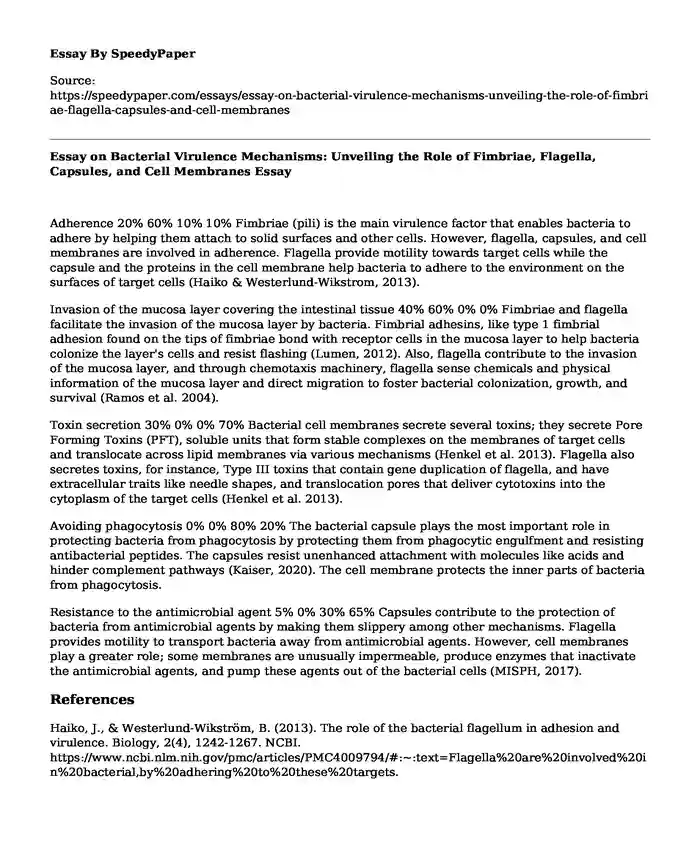Adherence 20% 60% 10% 10% Fimbriae (pili) is the main virulence factor that enables bacteria to adhere by helping them attach to solid surfaces and other cells. However, flagella, capsules, and cell membranes are involved in adherence. Flagella provide motility towards target cells while the capsule and the proteins in the cell membrane help bacteria to adhere to the environment on the surfaces of target cells (Haiko & Westerlund-Wikstrom, 2013).
Invasion of the mucosa layer covering the intestinal tissue 40% 60% 0% 0% Fimbriae and flagella facilitate the invasion of the mucosa layer by bacteria. Fimbrial adhesins, like type 1 fimbrial adhesion found on the tips of fimbriae bond with receptor cells in the mucosa layer to help bacteria colonize the layer's cells and resist flashing (Lumen, 2012). Also, flagella contribute to the invasion of the mucosa layer, and through chemotaxis machinery, flagella sense chemicals and physical information of the mucosa layer and direct migration to foster bacterial colonization, growth, and survival (Ramos et al. 2004).
Toxin secretion 30% 0% 0% 70% Bacterial cell membranes secrete several toxins; they secrete Pore Forming Toxins (PFT), soluble units that form stable complexes on the membranes of target cells and translocate across lipid membranes via various mechanisms (Henkel et al. 2013). Flagella also secretes toxins, for instance, Type III toxins that contain gene duplication of flagella, and have extracellular traits like needle shapes, and translocation pores that deliver cytotoxins into the cytoplasm of the target cells (Henkel et al. 2013).
Avoiding phagocytosis 0% 0% 80% 20% The bacterial capsule plays the most important role in protecting bacteria from phagocytosis by protecting them from phagocytic engulfment and resisting antibacterial peptides. The capsules resist unenhanced attachment with molecules like acids and hinder complement pathways (Kaiser, 2020). The cell membrane protects the inner parts of bacteria from phagocytosis.
Resistance to the antimicrobial agent 5% 0% 30% 65% Capsules contribute to the protection of bacteria from antimicrobial agents by making them slippery among other mechanisms. Flagella provides motility to transport bacteria away from antimicrobial agents. However, cell membranes play a greater role; some membranes are unusually impermeable, produce enzymes that inactivate the antimicrobial agents, and pump these agents out of the bacterial cells (MISPH, 2017).
References
Haiko, J., & Westerlund-Wikström, B. (2013). The role of the bacterial flagellum in adhesion and virulence. Biology, 2(4), 1242-1267. NCBI. https://www.ncbi.nlm.nih.gov/pmc/articles/PMC4009794/#:~:text=Flagella%20are%20involved%20in%20bacterial,by%20adhering%20to%20these%20targets.
Kaiser, G. (2020). The Ability to Resist Phagocytic Engulfment (Attachment and Ingestion) and Antibacterial Peptides. Biology Libretext. https://bio.libretexts.org/Bookshelves/Microbiology/Book%3A_Microbiology_(Kaiser)/Unit_3%3A_Bacterial_Pathogenesis/5%3A_Virulence_Factors_that_Promote_Colonization/5.5%3A_The_Ability_to_Resist_Innate_Immune_Defenses/5.5B%3A_The_Ability_to_Resist_Phagocytic_Engulfment_(Attachment_and_Ingestion)_and_Antibacterial_Peptides
Ramos, H. C., Rumbo, M., & Sirard, J. C. (2004). Bacterial Flagellins: Mediators of Pathogenicity and Host Immune Responses in Mucosa. Trends in Microbiology, 12(11), 509-517. https://www.hal.inserm.fr/inserm-00000046/document
Henkel, J. S., Baldwin, M. R., & Barbieri, J. T. (2010). Toxins from bacteria. In Molecular, Clinical and Environmental Toxicology. NCBI. (pp. 1-29). https://www.ncbi.nlm.nih.gov/pmc/articles/PMC3564551/
Lumen. (2012). Microbiology: Virulence Factors of Bacterial and Viral Pathogens. Lumen. https://courses.lumenlearning.com/microbiology/chapter/virulence-factors-of-bacterial-and-viral-pathogens/
Milken Institute School of Public Health. (2017). How Bacteria Build Resistance at the Cellular Level. The George Washington University. https://onlinepublichealth.gwu.edu/resources/antibiotic-resistance-at-cellular-level/
Cite this page
Essay on Bacterial Virulence Mechanisms: Unveiling the Role of Fimbriae, Flagella, Capsules, and Cell Membranes. (2023, Dec 07). Retrieved from https://speedypaper.net/essays/essay-on-bacterial-virulence-mechanisms-unveiling-the-role-of-fimbriae-flagella-capsules-and-cell-membranes
Request Removal
If you are the original author of this essay and no longer wish to have it published on the SpeedyPaper website, please click below to request its removal:
- Essay Example on Biotic and Abiotic Factors in an Ecosystem
- Free Essay on Sex Biases in Media
- Free Essay on Aboriginal Protection Board as a Form of Dispossession
- Free Essay Sample on the Madrars-Khanqah of Sultan Al-Ashraf Barsbay
- Essay Sample on Data Warehousing
- Compare or Contrast 2 Artworks. Free Essay
- Essay Sample on Kurt Lewin's Fundamental Equation
Popular categories





